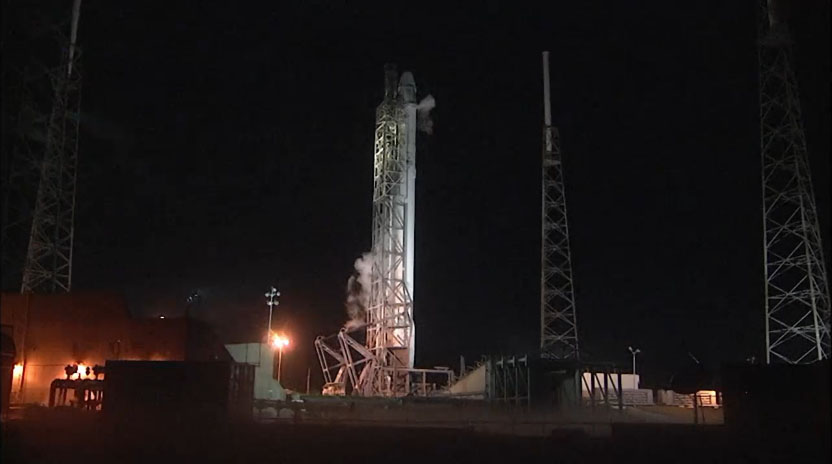SpaceX Aborts Dragon Spaceship Launch Due to Rocket Glitch

The private spaceflight company SpaceX aborted the planned launch of a Dragon cargo ship bound for the International Space Station early Tuesday (Jan. 6) due to a technical glitch with the spacecraft's rocket.
SpaceX called off the Dragon launch less than two minutes before its planned liftoff at 6:20 a.m. ET (1120 GMT) from the Cape Canaveral Air Force Station in Florida. NASA spokesman George Diller said an actuator issue on the second stage of the SpaceX-built Falcon 9 rocket launching the mission prompted the abort.
The technical glitch, known as "actuator drift," would have forced an automatic abort if left unchecked, he added. SpaceX engineers will review the issue in the hopes of making another launch attempt on Friday, Jan. 9, at 5:09 a.m. EST (1009 GMT). [How SpaceX's Reusable Rocket Test Works (Infographic)]
"That actuator drift issue will have to be resolved before Friday's launch attempt," Diller said.
According to a NASA update, sensors on the Falcon 9 rocket reported "actuator drift" in the thrust vector control system on the second stage of the 157-foot-tall (48 meters) rocket.
SpaceX's first Falcon 9 launch of 2015 actually a double mission of sorts.
The flight is primarily aimed at launching a Dragon cargo ship to the International Space Station to deliver NASA supplies. The flight, called Commercial Resupply Services 5 (CRS-5), is the fifth of 12 planned Dragon delivery missions by SpaceX under a $1.6 billion contract with NASA. The Dragon cargo ship is packed with 5,108 lbs. (2,316 kilograms) of food, water, gear and science experiments for the six-person crew currently living on the space station.
Breaking space news, the latest updates on rocket launches, skywatching events and more!
In addition to the delivery flight, the Hawthorne, California-based SpaceX also hopes to test an innovative reusable rocket landing technology as part of an internal program aimed at building reusable launch vehicles. For the test, SpaceX has outfitted the first stage of the Falcon 9 rocket with landing legs and stubby steering fins designed to fly the booster to a floating platform in the Atlantic Ocean.
SpaceX founder and CEO Elon Musk and other company officials have repeatedly stressed that the odds of success for the ambitious test are low, with Musk citing the chances as about 50-50.
If SpaceX is able to make a second launch attempt on Friday, NASA's live coverage will begin at 4 a.m. EST (0900 GMT), Diller said. You can watch the launch live on Space.com, courtesy of NASA TV and SpaceX.
Email Tariq Malik at tmalik@space.com or follow him @tariqjmalik and Google+. Follow us @Spacedotcom, Facebook and Google+. Original article on Space.com.

Tariq is the award-winning Editor-in-Chief of Space.com and joined the team in 2001. He covers human spaceflight, as well as skywatching and entertainment. He became Space.com's Editor-in-Chief in 2019. Before joining Space.com, Tariq was a staff reporter for The Los Angeles Times covering education and city beats in La Habra, Fullerton and Huntington Beach. He's a recipient of the 2022 Harry Kolcum Award for excellence in space reporting and the 2025 Space Pioneer Award from the National Space Society. He is an Eagle Scout and Space Camp alum with journalism degrees from the USC and NYU. You can find Tariq at Space.com and as the co-host to the This Week In Space podcast on the TWiT network. To see his latest project, you can follow Tariq on Twitter @tariqjmalik.
